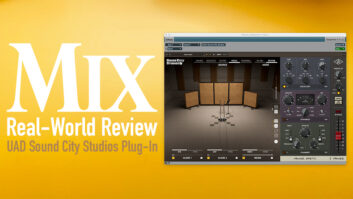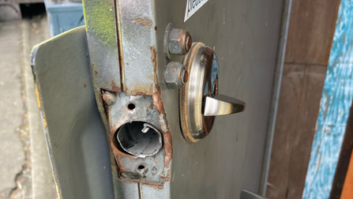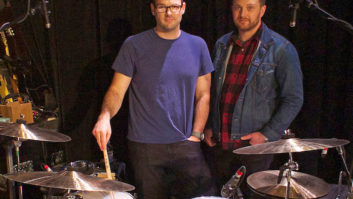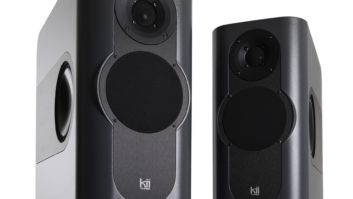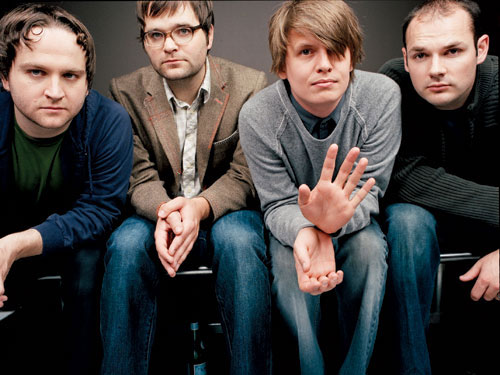
The increasing popularity of iTunes and music downloading has encouraged a number of people to announce the death of the album as a listening experience. Check out the countless releases that contain only a couple of good tracks amidst a lot of filler, and you won’t be surprised that there are those who say people only want to download singles.
However, Plans, the latest album by Seattle-based quartet Death Cab for Cutie, exudes the kind of thematic sweep and dynamic emotional flow found on those seamlessly sequenced classic albums that sneak up and get better with each listening. “This is a pretty introspective record,” says Nick Harmer, Death Cab’s bassist. “There are a lot [more] questions about growing older, responsibility and doubt than there are declarations and answers. I think this is cohesively the best batch of songs we’ve ever put together.”
Death Cab lead singer and principal songwriter Ben Gibbard explains it this way: “I don’t think there’s necessarily a story, but there’s definitely a theme here. One of my favorite kind of dark jokes is, ‘How do you make God laugh? You make a plan.’ Nobody ever makes a plan that they’re gonna go out and get hit by a car. A plan almost always has a happy ending. Essentially, every plan is a tiny prayer to Father Time. I really like the idea of a plan not being seen as having definite outcomes, but more like little wishes.”
At times, Gibbard’s voice recalls the intelligence and pensive sensitivity of Paul Simon. Part of that is underscored by the sense he values language and the way thoughts and words connect.
At other times, Gibbard’s voice sits in the mix with the kind of atmospheric richness of vocals heard on recordings by the Alan Parsons Project and Pink Floyd.
Conversations with the band clearly indicate they have paid a lot of attention to the production and compositional strengths of classic recordings by Pink Floyd, The Beatles, Peter Gabriel and Fleetwood Mac, as well as The Band, U2, Talk Talk and Brian Eno. Many of those qualities are evident in the grooves found in Plans. One particular album that received a lot of play was Dark Side of the Moon.
“I’ve been on a huge The Band and Pink Floyd kick over the last couple of years,” Gibbard says. “I’ve really just been obsessed with Dark Side of the Moon, which I bought several years ago. When I was a kid, I always thought, ‘Oh, that’s for hippie stoners and my parents’ friends, and that’s their record.’ I only bought it three or four years ago and it blows my mind to think that there was a time when a record as challenging and artful as that sold 40 million copies. It seems to me, now more than ever, I find myself listening to less contemporary music — my peers’ music — for lack of a better way of putting it.”
Chris Walla, DCFC lead guitarist/keyboardist, is also the producer. During the past few years, Walla has developed quite a reputation as a producer and engineer of substance, with credits including The Decemberists, Hot Hot Heat, the Postal Service and Nada Surf, as well as Death Cab for Cutie’s body of work.
Walla’s artful articulation of arrangement colorings and instrumental and vocal placement in the soundstage do much to highlight the band’s thoughtful musicality. “So many of the records people are putting out today kind of sound the same,” he says. “It feels like there is a rule book on how things are supposed to sound. When I started making records eight years ago, there wasn’t this feeling of, ‘This is what everyone’s doing,’ at least not for me.
“I think the more I do this, the more I realize I don’t really have an agenda when I work on a record,” Walla continues. “I’m not really setting out to do anything other than do whatever it takes to make the songs feel good. When somebody gets excited, I will take it as far as they will let me take it. I’m getting less and less hung up about whatever sounds I hear coming through the speakers, and more and more hung up on whether or not it moves me when it comes back.”
Walla’s ability to step out of his head and let instinct for the emotional truth blossom paid off handsomely with “I Will Follow You Into the Dark,” an unadorned solo performance with Gibbard on acoustic guitar. It is one of those songs that will probably be a future classic — certainly a track perfect for a major film soundtrack moment.
“We were going to track the vocal for another song and there was something screwy happening with the headphone mix,” Walla says. “We were having problems, so I said, ‘Ben, this is gonna be a few minutes. Take a break.’ Ben’s version of taking a break while we addressed the headphone problem was to pick up this Stella guitar that he loves and start playing this song we were planning on recording some time later during the sessions. He was still coming through the vocal mic as he was playing this, and it was sounding really cool to me, so I went up and said, ‘Let’s track this real quick,’ and we did and that’s what’s on the record. It was a mono recording with no effects. Nothing. I added a little compression and de-essed it a bit. It’s really weird. It’s totally there and it’s happening.”
While that song is an example of trusting the essence of a performance moment, “Soul Meets Body” (the first “single” off of Plans) is a masterfully sculpted piece of pop that sounds very simple, but is smartly nuanced and constantly changing. Walla describes the feel as a “disco song that has pretty much a bunch of acoustic instruments on it,” but that is due more to the way the kick drum and the accentuated hi-hat sit in the mix. “It’s run by a couple of acoustic guitars and a little DI’d acoustic guitar, as well as pianos, vibraphone and a four-part trumpet harmony that happens throughout the song,” says Walla. “I’m excited about that song, and I think it turned out really, really well.”
Even though Walla is the producer, there is no doubt that Death Cab for Cutie’s music and recording sensibilities are the result of a band mind-set. “It’s really democratic,” comments Walla. “We all listen to one another and are all really respectful of each other and trust that each of us are in this to make the best thing that we know how to make. If somebody pulls the alarm on something, everybody listens.”
One of the obvious developments in Death Cab’s ensemble work had to do with the entrance of drummer Jason McGerr. “Plans is only the second record we’ve ever made with the same lineup,” says Gibbard, who is a drummer himself. “Jason’s been a friend of ours for years, but he joined the band in late 2002. He’s really good at focusing in on the songs and not having the fact that he’s a great drummer become the most important thing in the music.”
Plans was recorded at Long View Farm in North Brookfield, Mass., with additional recording was done at Avast!, Robert Lang Studios, The Hall of Justice and Skrocki in Seattle. The album was mixed at Smart Studios in Madison, Wis. Other engineers who assisted were Mike Lapierre, Kip Beelman, Robbie Skrocki, Beau Sorenson and Chris Shaw, who mixed “Crooked Teeth” at Soundtrack in New York.
Throughout the band’s career, Death Cab has always made it a point to record analog and even release heavy-duty vinyl versions of their albums. With each release, there has been a palpable improvement in recording sonics and production smarts. They even released an SACD version of their last album, Transatlanticism.
Interestingly, the band still programs their sequencing as if vinyl was the format destination. “Our conversations still revolve around listening to records, and we still make our running orders based off of vinyl,” says Harmer. “We talk about things being inside and halves and what does the first half and second half do? We are always making sure there’s a good consistency and flow. Transatlanticism on vinyl sounds amazing. It is a really nice pressing on heavy vinyl. We used all analog production straight through and never touched digital. We are very happy with that.”
Mastering for Plans on vinyl and CD was done by Roger Seibel at SAE Mastering in Phoenix. “Roger’s process for mastering was unlike others I’ve had,” says Walla. “He tweaks in several stages — some analog EQ and compression on the front end before conversion, some in the digital realm with the Weiss. Lots of de-essing on this particular record. Roger monitors everything at 16-bit/44.1 kHz as it ends up on CD. Very nice that way — to leave with a record that sounds like it did in the mastering room, rather than the dithering nightmare that so often happens on the tail end when you get the record to your car.”
At a time when it seems that fidelity, dynamics and spaciousness are almost forgotten art forms in the world of rock and pop, Plans is rich with interweaving motifs and rewarding ambient detailing. “Fidelity wise, the last record [Transatlanticism] was a great leap forward for us,” says Harmer. “If I listen back to our old records — I’m not unhappy with them at all, but what I hear in each record is us really maximizing every available piece of technology that we had in front of us at the time.
“Each record is a step up to better machines, better outboard gear, better microphones, plus you can also hear Chris’ [Walla] learning curve get steeper as we progress into our career,” he continues. “He learns more and tries more things, gets better at certain things. I’m so excited about the overall sound of the record. There’s so much depth and density in each song, and I’m very happy about a lot of little moments and discoveries that are really catching my ear. I’m very proud.”
Even though the band emerged from the indie music world on the Barsuk label, Gibbard expresses frustration at how a number of indie enthusiasts have a perplexing way of championing bad-sounding recordings.
“I remember going to the bank so we could buy an [AKG] 414 when we first started years ago. This was a really important moment in the fidelity of the band. We were going to buy this expensive, really nice microphone, and the woman behind the bank counter said, ‘Oh, are you guys buying a car?’ Chris said, ‘No, we’re buying a microphone,’” Gibbard says with a laugh. “Of course, the 414 ended up on everything ’cause it was the only good mic we had. I think every record we’ve done since, there are the indie snobs who’ll say, ‘Oh, everything’s getting too produced and too slick.’ I think that we’ve always wanted to make the best-sounding records we could make, and with every record, we’ve had a little bit better equipment and a little more money to increase the fidelity and make things sound fuller.”
Walla and the band made the leap from straight analog multitrack to digital for Plans when they discovered the iZ RADAR S-Nyquist (192kHz I/O) with the Adrenaline Plus recording engine. Even though he had resolutely resisted other digital formats, Walla sensed a change might be in order.
“I felt I needed some more flexibility because I was doing projects where other mix guys might be involved,” Walla says. “It seems nobody wants to send reels of tape anymore and some places don’t have tape machines. I was just starting to feel a little bit left behind, but when I would talk to people about Pro Tools or Nuendo, they were like, ‘Yeah, it’s cool. It’s good.’ But I couldn’t find anybody who felt passionate about their digital system the way the hardcore tape guys felt about tape. There’s just so much raw data you have to deal with that the documentation process in the digital world seems kind of nuts. Where it once took one or two people, it seems like it takes a village to make a record now.”
Walla found a very similar passion in people who had jumped to RADAR. “People I respected were saying, ‘This is what you need to do. This is a great system. It sounds great and is totally rock-solid. When you start using it, you will find that your session will move like when you’re working on tape,’” enthuses Walla. “I think that’s true, because I still end up punching performances. I don’t do a lot of editing and moving stuff around and that part of it is really nice. The company itself is great and if I have a question or a problem, you call them and you actually get somebody on the phone. I heartily recommend RADAR to anybody who was thinking about doing the digital thing and wants to keep some part of their analog process intact.”
Walla’s other favorite production devices include the Chandler Limited TG1 Abbey Road Special Edition (a re-creation of the classic ’60s-era EMI TG12413 limiter), the Millennia HV-3D 8-channel microphone preamplifier and a rather arcane unit by Lexicon called the Varispeech time compressor/expander, which he likes to use to enhance drums — particularly snare — sounds.
“I don’t think I’ll be going anywhere without that any time soon,” Walla says of the Chandler. “It makes everything sound like a little angel. It’s all over the whole record: piano, vocals, bass guitar, drums, like drum overheads. Everywhere I could smash it in, I did. I really like it a lot.”
Still, Harmer says, “There are a lot of built-in dynamics in our music; it’s something we think about a lot. There is a tendency for people to want their records to have this immediate sound that’s cranking and loud. It’s almost like an assault and it sort of crushes you sonically from the top.”
Adds Walla, “Trying to make everything sound like it’s rockin’ on your car radio is not really the goal.”
That said, Plans certainly has its share of radio-friendly pop. But Death Cab for Cutie clearly embraces the idea of the album as a complete experiential piece. “I don’t know if this is a function of what I’ve [been listening] to, but the idea of making a record that is just 10 songs in a row seems like the most boring thing in the world to me,” says Gibbard. “The idea of making records that are meant to be listened to as a more continual piece of music is something we’re all more interested in doing as we continue to be a band.”

